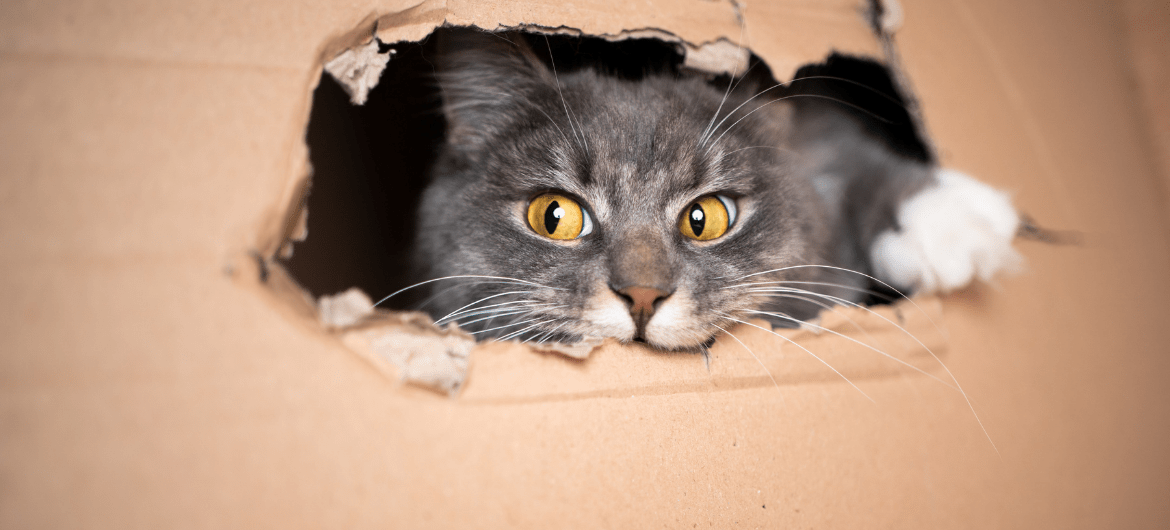Special Note! This site contains affiliate links. If you click a link AND make a purchase we MAY make a small commission. The process costs you nothing. It is just how the company spends its advertising dollars.
A cat in a box is a sight that is probably not alien to any cat person. If we want to answer the question contained in the title of this article, we should take into account the fact that our purrfect charges are equally eager to enter drawers, cupboards, sinks and even bags.
All these places have one thing in common: they make pretty good hiding places, at least from the cat’s point of view. And right there lies the answer to the question of why cats like boxes. Our pets, although they are efficient, well-armed hunters themselves, are exposed to attacks by other predators due to their small size. So they need a safe shelter.
Why does a cat enter a cardboard box?
Cats’ love of cardboard boxes has several reasons. The first one is stress reduction, cats can reduce their tension and stress levels thanks to boxes. A study by researchers found that cats who have a cardboard box available to them stress significantly less than those without cardboard boxes. This is the main reason for cats’ love for cardboard boxes. Purrs like to hide when resting or when observing, as well as hunting, as you can guess – a cardboard box provides the perfect place for this.
A cat in a box has a perfect observation point, and at the same time, no one and nothing can surprise it there. He is protected by the walls of the cardboard box – this blocks not only his view but also to some extent his smell. In addition, the kitty can hide in the box because he simply wants to have a better position to play with another cat or another pet – he himself is perfectly protected and can carry out more effective “attacks”. Surely at least once you have witnessed a situation in which a cat sits safely hidden in a cardboard box and attacks with its outstretched paw.
Why do cats like cardboard boxes so much?
- Increase the sense of security – remember that the cat in nature is an animal that has many enemies (in its natural environment it is, after all, in a double role: predator and prey). Therefore, in moments of danger, it often chooses to escape, and then tries to observe the environment from a distance. Cardboard allows us to recreate this pattern at home. The principle favored by cats works here, which is “to see but not to be seen”;
- Better heat management – research conducted on the feline preference for ambient temperature shows that many pets feel the cold in our homes. This is especially true for cats with reduced hair coat, but not only – after all, but cats also are native to desert areas and for many of them a place that is at least a little warmer than the rest of the space is tempting. Meanwhile, the small space of a cardboard box is easier to heat, and what is more, the plastic partly insulates, e.g. from a cold floor. So it is cat friendly;
- An additional variety of the space – adding a few cardboard boxes at home is one of the simplest and cheapest methods of expanding the cat’s environment and making it more varied. Additionally, cardboard boxes are excellent carriers of scents, which encourages pets to scratch them, rub their cheeks, and even bite them, which allows individual pheromone markers to be transferred to the cardboard surface, among other things.
- The box can be a training element – for those cats who enjoy a training challenge, the cardboard box can become an additional piece of equipment, introduced into training sets. These can be agility training but are also directed at remodeling behaviors undesirable to the caregiver.
Why do cats chew cardboard boxes?
Cats may see a cardboard box not only as a great place to rest but also as a toy, in which case they scratch and bite it. In this situation, self-built cardboard cat houses can work – you will need boxes, of course, as well as hot glue and some creativity. Before you start to erect the structure, make sure that there is no tape, staples, or other elements on the boxes that can pose a threat to the pet. The advantage, in this case, is that even if your pet destroys such a house, you can easily replace it with a new one. You can also easily adjust the appearance and size of such a structure to your specific needs.
You May Also Like:





